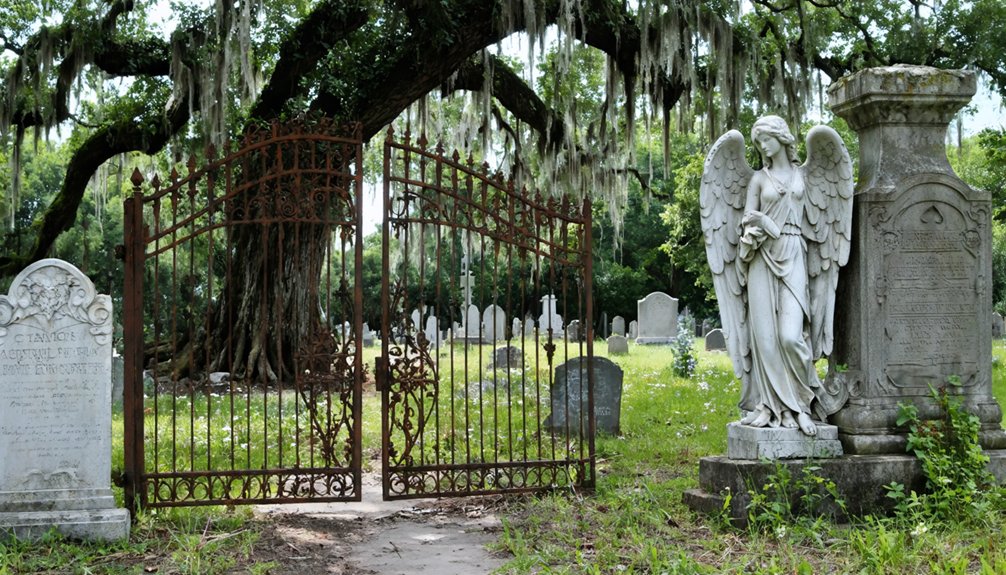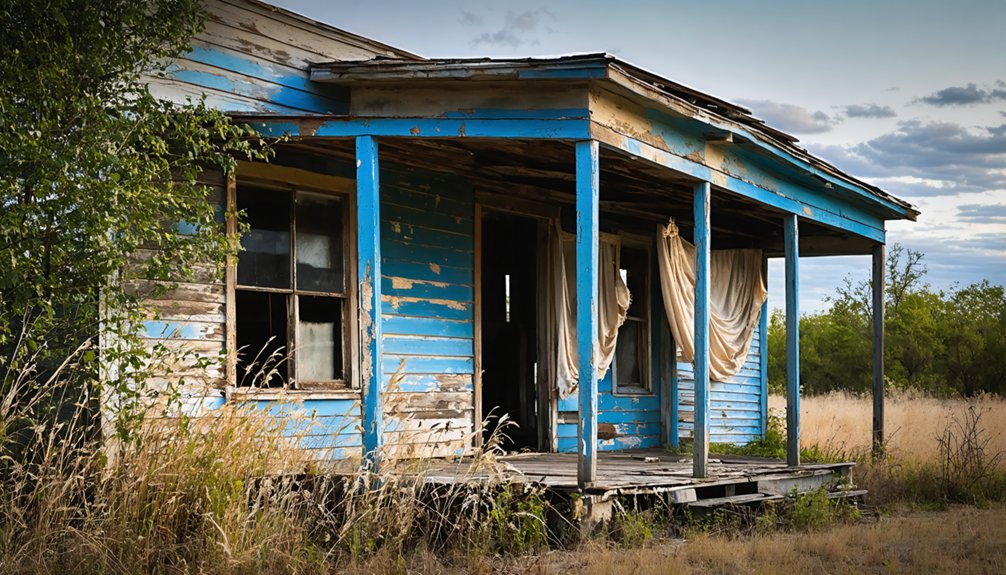You’ll find the remnants of Sumpter, Texas in Trinity County, where it once thrived as the county seat from 1850 to 1873. The town boasted a bustling courthouse square, mills, plantations, and a vibrant commercial district until a catastrophic courthouse fire in 1872 sparked its decline. When officials relocated the county seat and railroads bypassed the area, Sumpter’s fate was sealed. Today, only the historic cemetery stands as a silent witness to this lost community’s story.
Key Takeaways
- Sumpter was Trinity County’s original seat established in 1850, centered around Solomon Adams’ store and featuring a courthouse and schoolhouse.
- The town thrived with mills, plantations, and a vibrant commercial district until an 1872 courthouse fire devastated the community.
- Loss of county seat status in 1873 and being bypassed by the railroad led to Sumpter’s eventual transformation into a ghost town.
- Only Sumpter Cemetery remains today, marked by a 1936 granite marker and containing over 125 graves from the town’s history.
- The former townsite now lies beneath pine forest and ranch land, with no visible remains of the courthouse, stores, or homes.
The Rise of a Promising Texas Town
While many Texas towns emerged during the mid-1800s, Sumpter’s establishment as Trinity County’s seat in 1850 marked the beginning of what promised to be a thriving community.
You’ll find that early settlement patterns centered around Solomon Adams’ general store and hotel, with a modest courthouse and log schoolhouse anchoring the town’s civic life. The region’s agricultural influence grew as plantations dotted the surrounding landscape, creating a robust economic base. The town’s development began under the guidance of seven appointed commissioners. Like other Texas settlements of the era, Sumpter’s future seemed secure until railroad rerouting sealed its eventual fate.
When Goodwin Woodson and R.D. Crow opened their saw and grist mill in 1857, they sparked a dramatic transformation in Sumpter’s development. Within five years, the town had incorporated, boasting a larger courthouse and a bustling square filled with drugstores, saloons, and merchants – all signs of a promising frontier settlement.
Life in Early Sumpter
You’d find early Sumpter bustling with activity around its central courthouse square, where Solomon Adams’s multipurpose general store-hotel anchored a growing commercial district filled with drugstores and saloons.
Local entrepreneurs like Goodwin Woodson and R.D. Crow transformed the economy when they established the saw and grist mill in 1857, while skilled artisans such as Roach May and her daughter crafted fine ball gowns for the town’s social events.
The mix of mills, plantations, and specialty trades created a vibrant marketplace where you could purchase everything from daily necessities to custom-made goods. Sumpter’s first courthouse was established when Trinity County designated it as the county seat in 1854. The town’s prosperity continued until it became a ghost town after being bypassed by the railroad.
Early Business and Commerce
The economic foundations of early Sumpter took shape around Solomon Adams’ pioneering general store, which served as both a commercial hub and makeshift hotel for travelers. The store established vital business networks for the fledgling settlement, connecting local residents with essential supplies and creating space for community exchanges. County officials operated from Adams’ residence before a proper courthouse was built.
You’d have found a bustling commercial district around the courthouse square, where drugstores and saloons conducted brisk trade. The town’s economic engine gained momentum in 1857 when Goodwin Woodson and R.D. Crow opened their saw and grist mill four miles south. The mill’s operation provided timber processing jobs that helped sustain the local workforce.
Local seamstresses like Roach May and Elizabeth May Gates crafted custom clothing, while plantations supported the agricultural sector. Without banks, you’d have conducted your business through cash or barter, as was typical in frontier settlements of that era.
Social Life and Entertainment
Despite its frontier setting, social life in early Sumpter revolved around a vibrant community hub at the courthouse square, where residents gathered daily to conduct business and share news.
You’d find locals frequenting nearby drugstores and saloons, while Solomon Adams’ general store served as a popular meeting spot for travelers and townspeople alike.
Community gatherings often centered around the log schoolhouse, which hosted both educational and social events.
Social interactions extended to church meetings, while women participated in sewing circles, with skilled seamstresses like Roach May crafting elegant ball gowns for formal occasions.
The town’s social fabric was strengthened through mutual support networks, storytelling sessions, and outdoor activities in the surrounding pine forests, though these frontier entertainments weren’t extensively documented in historical records.
The devastating courthouse fire of 1872 marked the end of many social gatherings as residents gradually dispersed to neighboring towns.
The Devastating Fire and County Seat Loss
When flames consumed Sumpter’s Trinity County courthouse in November 1872, the catastrophic blaze set in motion a chain of events that would ultimately transform this once-thriving community into a ghost town.
The fire’s impact devastated not just the building itself, but also Sumpter’s future as a viable town.
The courthouse fire did more than destroy a building—it extinguished Sumpter’s hopes for survival as a community.
Just like the Town Hall building in Michigan’s Sumpter Township, important administrative structures shaped the destiny of communities.
Similar to Sumpter, Oregon’s own Capital Hotel fire in 1917 would later destroy nearly 100 buildings and mark another town’s decline.
You won’t find records of casualties or the fire’s cause, but you’ll discover its most significant consequence: the loss of county seat status.
By May 1873, just six months after the fire, Trinity County officials had relocated their operations 20 miles southwest to the town of Trinity.
Without its administrative heart, Sumpter’s population dwindled rapidly.
Unlike other ghost towns that faded slowly due to economic changes, Sumpter’s fate was sealed by this single, devastating event.
Railroad Bypass and Abandonment
As if losing the county seat wasn’t devastating enough, Sumpter faced another major blow that sealed its fate: the railroad’s decision to bypass the town completely.
You’ll find that this decision proved catastrophic for a community that had banked its future on becoming a major railroad hub. The railroad’s significance in Texas during this period can’t be overstated – it meant the difference between prosperity and abandonment.
The economic ramifications were immediate and severe. Without rail connectivity, Sumpter’s agriculture and lumber industries couldn’t compete with neighboring towns like Trinity, which flourished with their new railroad access. Unlike the successful Oregon Lumber Company that thrived along railroad routes in other regions, Sumpter’s timber operations were doomed without proper transport.
You can imagine the exodus that followed – businesses shuttered, residents relocated, and dreams of commercial success evaporated. What was once a promising settlement became another Texas ghost town, forever altered by a single infrastructure decision.
Legacy in Stone: Cemeteries and Markers

You’ll find Sumpter Cemetery just west of the 1936 pinkish granite marker, where it stands as the primary physical remnant of this vanished town.
The cemetery’s grounds, now blanketed by pine forest, contain over 125 unidentified graves and feature a designated section for Black burials that emerged when the nearby Josserand Cemetery reached capacity.
Through dedicated preservation efforts, including Emma Young’s documentation work and multiple transcription projects since 1980, the cemetery continues to tell the stories of Sumpter’s earliest settlers, influential families, and African American residents like seamstresses Roach May and Elizabeth May Gates.
Historical Burial Grounds
What remains of the once-thriving town of Sumpter can be found in its historic cemetery, established in 1840 and marked by a distinctive 1936 pinkish granite marker.
You’ll discover a remarkable reflection of early Texas burial practices, with both Black and White residents sharing this sacred ground, though segregation is still evident in the 2004 “Black Section” addition.
- The cemetery’s historical significance lies in its status as the last physical remnant of Trinity County’s original seat.
- You’ll find documented graves through historical markers and cemetery lists from 1980 and 1992.
- Notable burials include Roach May, though many graves remain unidentified.
- The site’s survival, now surrounded by ranch land and pine forest, provides a window into the region’s pioneering spirit.
Cemetery Preservation Efforts
Since the 1980s, preservation efforts at Sumpter Cemetery have focused on maintaining this crucial piece of Trinity County’s heritage through community-driven initiatives.
You’ll find dedicated volunteer efforts leading regular cemetery cleanup days, where local organizations work alongside state preservation programs to protect and restore historic markers and gravesites. Community tours now showcase the cemetery’s historical significance, particularly highlighting sections that reflect the area’s complex racial history.
If you’re interested in joining preservation activities, you’ll need to follow strict conservation guidelines that prioritize gentle cleaning methods and authentic restoration techniques.
The Texas Historical Commission provides technical assistance, and you must adhere to state regulations when undertaking any preservation work. Your efforts help document and protect both marked and unmarked graves while preserving this critical link to Sumpter’s past.
Markers Tell Stories
Stone markers throughout Sumpter Cemetery chronicle the town’s complex history, from its earliest burials in 1840 through its decline after 1872.
You’ll find grave narratives etched in both humble stones and a prominent 1936 granite marker, each telling stories of the community’s pioneers, including seamstresses like Roach May and her daughter who crafted ball gowns for local celebrations.
Historical preservation efforts reveal:
- More than 125 unidentified graves in the segregated Black section speak to the era’s racial divisions
- Wooden crosses and simple stone inscriptions reflect the modest means of many residents
- Early settler graves connect directly to Trinity County’s founding families
- Marker materials and styles illuminate social status and burial customs across different time periods
Traces of a Lost Community

Although Sumpter has long vanished into the East Texas wilderness, several tangible remnants offer glimpses into this once-thriving community’s past.
You’ll find the most poignant community memories in Sumpter Cemetery, where over 125 graves tell stories of the town’s diverse population, including both white and Black residents. The cemetery’s segregated sections reflect the cultural significance and complex social dynamics of 19th-century Texas.
While the courthouse, stores, and homes have disappeared beneath pine forest and ranch land, you can still trace the town’s footprint through historical records.
These document the presence of seamstresses like Roach May, Solomon Adams’ general store, and Woodson and Crow’s mill – each contributing to Sumpter’s brief but vibrant existence as Trinity County’s first seat of government.
Frequently Asked Questions
What Happened to John Wesley Hardin After Leaving Sumpter?
You’ll find Hardin’s legacy intensified after Sumpter’s demise, as he killed multiple lawmen, joined the Sutton-Taylor feud, faced imprisonment for 25 years, then surprisingly became a lawyer in El Paso.
Were There Any Native American Settlements in the Sumpter Area?
Ever wonder about ancient footprints in Texas soil? While you won’t find documented Native settlements in Sumpter specifically, the Atakapa’s cultural impact extended throughout East Texas, though records remain limited.
How Did Solomon Adams Acquire the Land for Sumpter?
You’ll find that Solomon Adams’ exact land acquisition method isn’t fully documented due to courthouse fires, but he likely obtained the land through state grants or legislative approval during Texas’ settlement period.
What Became of the Families Who Left Sumpter?
You’ll find family legacies scattered across Trinity County, as residents migrated to nearby towns and ranches. Most adapted by becoming farmers, while maintaining their social ties through cemeteries and oral histories.
Did Any Businesses Successfully Relocate From Sumpter to Groveton?
Like scattered seeds in the wind, you’ll find little evidence of direct business relocation from Sumpter to Groveton, except for D.H. Hamilton’s mill operations following the county seat’s transfer.
References
- https://www.youtube.com/watch?v=lSVYbUa2VAc
- http://sites.rootsweb.com/~txtrinit/cemetery/sumpter.htm
- https://www.hmdb.org/m.asp?m=120967
- https://discovertexasoutdoors.com/places/sumpter-texas-ghost-town-trinity-countys-lost-county-seat/
- https://texashistoricalmarkers.weebly.com/site-of-the-town-of-sumpter.html
- https://www.texasescapes.com/EastTexasTowns/Sumpter-Texas.htm
- https://www.tshaonline.org/handbook/entries/sumpter-tx
- https://www.county.org/county-magazine-articles/summer-2025/ghost-towns
- https://www.texasstandard.org/stories/texas-population-boom-ghost-towns-rural-urban-suburban-shift/
- https://authentictexas.com/texas-ghost-towns/



